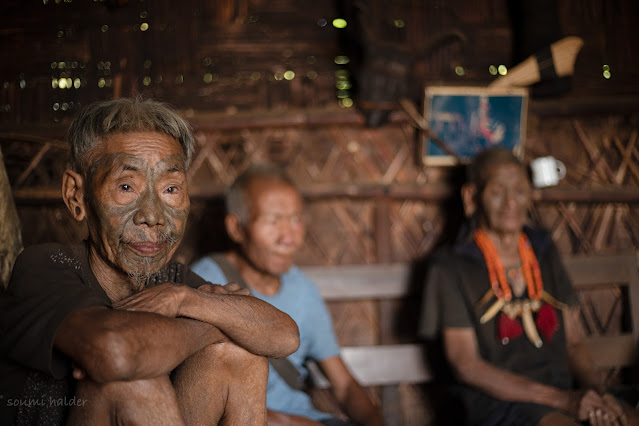Dusk sets in earlier here than the rest of the country . It’s just about 5pm and the sky has turned into a slate. We are in Mon, homeland and territory of the Headhunting Warrior Tribe, The Konyaks.
Situated in the North East of India, Mon is the northernmost district of Nagaland bordered by Myanmar, Arunachal and Assam. Over the next few days we are to explore remotely located hilltop villages situated in the midst of dense/moderately dense forests. With no communication with the outside world they remained un-discovered until recent times.The Konyaks form the largest ethnic tribes of Nagaland. Headhunting was a tradition practiced for many centuries by the Konyaks. Conflicts arising due to land, river, territory, could lead to an inter-tribe warfare and defeating the other side was not final until the enemy was beheaded .
It was a matter of honor and pride for those involved in beheading the enemy and were highly revered . With every addition of the “head” count, their rank within the tribe also moved up . To return home with the enemy's head was considered a prized trophy and basis folklore, they believed the soul or the spirit resides in the skull and to capture the enemy’s head meant his spirit has been captured and that it would bring prosperity to the villages and the lands would be more fertile.
Everytime a headhunter returned with his trophy, it earned him facial tattoos . This was also to identify and distinguish them as more powerful and revered. The tattooing process was an extremely painful process due to the method involved (and I am not getting into that) ! The process had to be completed over one continuous sitting , morning to night or carried over the following day until completed.
A chief or “Angh” was designated for every Konyak Village. One who had the highest number of skulls to his credit was entitled for this position. So that the Chiefs could be easily identified, they wore strings of blue beads on their legs.
Today , this is the Last Generation of Tattooed Headhunters Alive. They are all above 85-90 years.
The practice was totally banned only in the late 1960s, yes as recent as a little over 50 years back. With the arrival and influence of Christian missionaries (starting around mid 19th Century) and the practice being finally banned, the human skulls which earlier adorned their homes and Morongs (community halls) had to be buried and now are replaced by the skulls of buffaloes, mithuns, boars and other animals.
The current generation and many young Konyaks have access to education and an option to choose a life in complete contrast to their forefathers. Perhaps it is only a matter of time or few decades, that the origins of a culture and customs of a fierce powerful tribe will gradually fade away under the modern influences.







